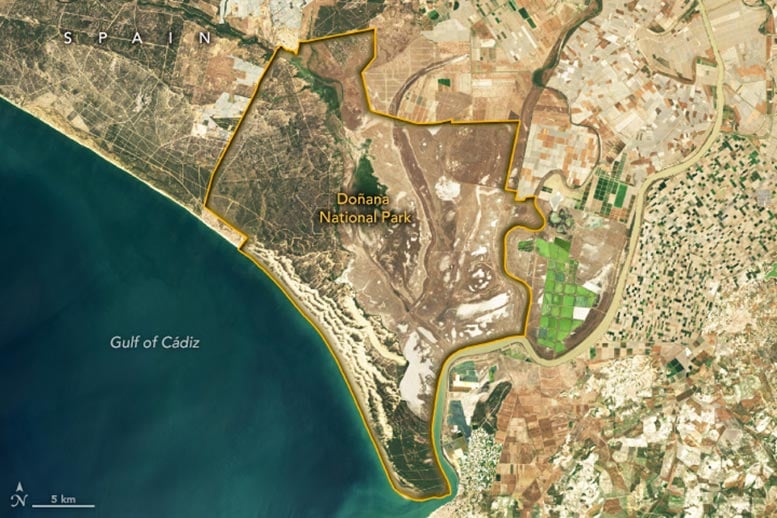Revival of Ecosystem in Doñana National Park Triggered by Spring Rainfall

A satellite image taken by the Operational Land Imager on Landsat 8 on April 15, 2023, showed Doñana National Park.
The Operational Land Imager-2 on Landsat 9 captured another satellite image of Doñana National Park on April 9, 2024.
During spring 2024, heavy rainfall brought temporary relief to Doñana National Park in Spain, that was struggling with drought. Although this boosted wetland recovery and wildlife populations, long-term water issues continue to persist.
In spring 2024, the protected wetlands of Spain’s Doñana National Park received a break from the ongoing drought. Rain in late March filled marshes, small temporary ponds and rejuvenated the vegetation in this distinct habitat.
For larger than a decade, the region received less than the typical rainfall levels. The situation worsened drastically in the last three years noted with some of the lowest yearly rainfall records. The entire country is grappling with drought conditions worsened by unusually high temperatures.
January 2024 marked the warmest January ever recorded in Spain, with temperatures 2.4 degrees Celsius or 4.3 degrees Fahrenheit above average. The first quarter of 2024 might have been the warmest since record-keeping started in 1961.
Doñana National Park located in the Andalusia region witnessed significant relief after heavy rains in late March 2024. Images show the area on April 15, 2023, and April 9, 2024. The latter was taken after a period of heavy rain. These images were captured by the OLI on the Landsat 8 satellite and the OLI-2 on Landsat 9, respectively.
Greenhouses and agricultural fields surround the protected area. The park is recognized as a UNESCO World Heritage Site and Biosphere Reserve and a Ramsar Wetland of International Importance.
According to a weather station in the park, Doñana National Park received 145 millimeters or 5.7 inches of rain in March 2024. It was the second wettest March ever recorded. More than 400 millimeters of rain have already fallen in the current water year, which runs from September 2023 through August 2024.
However, the rainfall remains less than the historical annual average of over 500 millimeters, even though it is more than what was recorded in each of the previous three full water years.
The western part of the park comprises thousands of small, shallow pools. Rain resulted in floods in several larger ponds at the Doñana Biological Station. Inland marsh areas also witnessed flooding, but some portions stayed dry.
The protected area's water demands are depleting the underlying aquifer due to development in surrounding regions. An increase in cultivating water-intensive crops around the park and groundwater extraction by a nearby resort town are putting pressure on the wetlands.
A 2023 study revealed that in the past few years, many intermittent ponds had minimal flooding and for less duration, some even remained dry for at least 10 years.
Water shortage led to a decrease in wildlife populations in Doñana National Park's marshes, wetlands, and dunes. According to the Doñana Biological Station report, less flooding affected breeding waterfowl, amphibians, fish as well as butterflies and endangered plants. But the flooding in spring 2024 promoted growth of plants favoring breeding waterfowl like coots, grebes, and herons.
Despite the changes on the surface, experts warn against seeing this as a long-term solution to the water shortage.
Javier Bustamante, a researcher at the Doñana Biological Station, said, "The rains have partially eased the immediate drought issues, but they do not solve the invisible problem of over-exploitation of groundwater." He added that only in the coming months, the rainfall's impact would become more evident.
Wanmei Liang created the NASA Earth Observatory images using Landsat data from the U.S. Geological Survey and boundary data from ProtectedPlanet.




